How To Find Active Directory
Agile Directory Users and Computers (ADUC) is one of the most pop tools for managing Agile Directory on Windows servers. This article explains how to go started with ADUC.
What is Active Directory Users and Computers (ADUC)?
ADUC is a Microsoft Management Panel (MMC) snap-in that enables administrators to manage Agile Directory objects and their attributes. For example, they can:
- Change passwords
- Reset user accounts
- Add users to security groups
- Create and delete organizational units (OUs)
- Handle FSMO roles like RID primary, PDC Emulator and infrastructure primary
- Create and manage computers, groups and users and their attributes
- Delegate control of objects
- Define advanced security and auditing in AD
You tin can find more information most Active Directory in our AD tutorial for beginners.
ADUC Avant-garde Features
If you enable the Advanced Features setting in ADUC (using the View window), you tin also manage:
- LostAndFound container
- NTDS quotas
- Programme data
- System information
Enabling Advanced Features adds many tabs to the properties page of an object, including Published Certificates, Attribute Editor and Countersign Replication.
How to enable Active Directory Users and Computers
Your Active Directory domain controllers (DCs) will take ADUC installed past default.
To manage your servers and computers remotely, yous should install Remote Server Administration Tools (RSAT) for Windows. RSAT enables IT administrators to remotely manage Windows Servers, roles and features in your surroundings from a Windows motorcar, and includes ADUC as part of the Role Administration Tools. Note that RSAT can be installed only on computers that are running Professional or Enterprise versions of Windows.
Installing ADUC in Windows 10
How you lot install ADUC depends on your version of Windows, as detailed below.
Installing ADUC on Windows x version 1809 or college
Starting with the October 2018 update to Windows ten, RSAT is included as a set of "Features on Need," so yous don't demand to download and install information technology. To enable the ADUC tool, take these steps:
- OpenSettings from the Start bill of fare (or pressWin-I).
- Open the Apps & Features, ClickManage optional features at the top of the page and select Add a feature.
- Select theRSAT: Active Directory Domain Services and Lightweight Directory Tools box and clickInstall.
Installing ADUC using the command line
Alternatively, if y'all're using Windows 10 version 1809 or afterwards, you tin can install ADUC from the command line as follows:
- Click Outset(or pressWin+R). Type "cmd" and click Enter.
- Run following commands:
dism /online /enable-feature /featurename:RSATClient-Roles-Advertising dism /online /enable-feature /featurename:RSATClient-Roles-Advertising-DS dism /online /enable-feature /featurename:RSATClient-Roles-Advert-DS-SnapIns
Enabling ADUC on Windows x version 1803 or below
For before versions of Windows x, you need to manually download and install the advisable Remote Server Administrator Tools for your version of Windows. All tools, including ADUC, are enabled by default.
If you demand to manually enable ADUC, take the following steps:
- Open theControl Panel from the First menu (or pressWin-Ten).
- Go toPrograms > Programs and Features >Plow Windows features on or off.
- Get toRemote Server Administration Tools> Role Assistants Tools > Advertisement DS and Advert LDS Tools.
- Check theAD DS Tools box and clickOK.
Fixing RSAT errors in Windows ten
RSAT can crash for diverse reasons, including a failed update, a corrupt installation file or operating organization incompatibility. In addition, bug tin occur if a server administrator attempts to modify any of its administration tools, especially the Active Directory Administrative Center (ADAC) component of RSAT.
Take these steps to troubleshoot errors:
- Brand sure you lot have the correct RSAT version for your operating system versions. In some cases, uninstalling RSAT and setting up a new uniform version resolves the crash issues.
- If y'all get RSAT installation mistake 0x800f0954:
- Correct-click theFirstpush > ChooseRun > Typemsc > ClickOK.
- In the local grouping policy editor, navigate toComputer Configuration>Authoritative Templates>System.
- Right-click"Specify settings for optional component installation and component repair"policy > Set it toEnabled > Check the box "Download repair content and optional features direct from Windows Updates instead of Windows Server Updates Services (WSUS)".
- ClickApply > ClickOK.
- Right-click theStartpush > ChooseRun> Typegpupdate> ClickOK.
- RSAT installation error 0x80070003 is commonly related to installation from an uncommon location. Copy the installation files to the target machine's local drive and proceed.
Installing ADUC on older versions of Windows
If you accept an older version of Windows, you lot can download the appropriate RSAT package so useAdd Windows features in the Control Panel to add together the necessary MMC snap-ins.
Note that if you install RSAT on a computer running Windows 7, y'all must enable the tools manually afterwards RSAT installation. Go to Start > Control Panel > Programs and Features and use Turn Windows Features On and Off.
Using ADUC
To start the ADUC panel, click Start, navigate to Administrative Tools and click Active Directory Users and Computers.
Add a user
1. Select the domain where y'all want to add the user, and and then expand its contents.
two. Right-click the container y'all want to add together a user to (usually Users), select New and so click User.
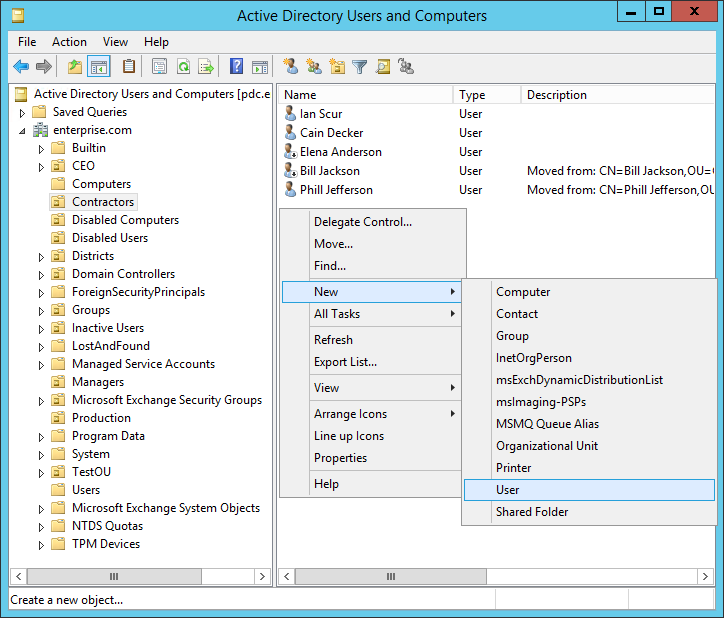
3. Type the new user's first name, terminal name and logon name. Then click Next.
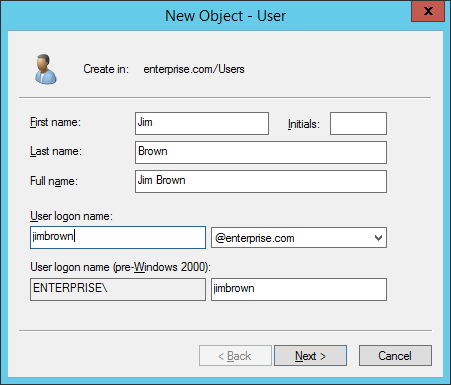
4. Blazon and confirm a new password for the user. Make certain you lot enable ane of the following options to control how the user must manage their password:
- User must change password at next logon
- User cannot modify countersign
- Password never expires
- Account is disabled
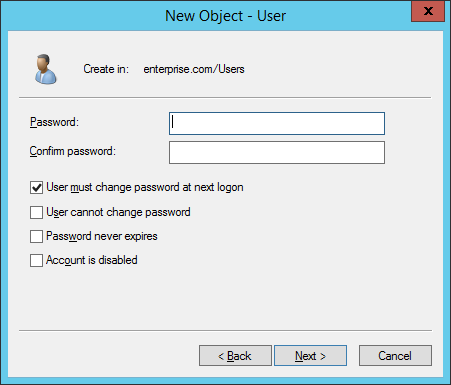
v. Click Next.
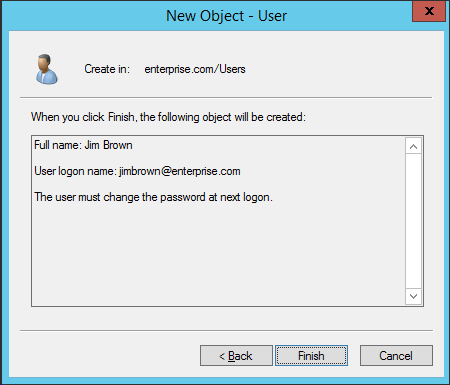
half dozen. Make certain everything yous entered is correct and and then click Finish.
Add together a user to a grouping
1. Right-click the domain in which yous want to add a user to the group and then select Notice.
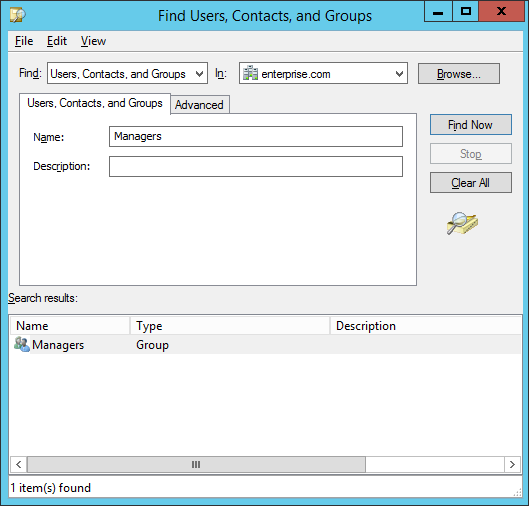
2. Select Users, Contacts, and Groups in the Observe dropdown list.
iii. Enter the name of the group you want to add together the user to, click Find Now, select proper group in search results and click OK.
4. Go to Activity > Properties and select the Members
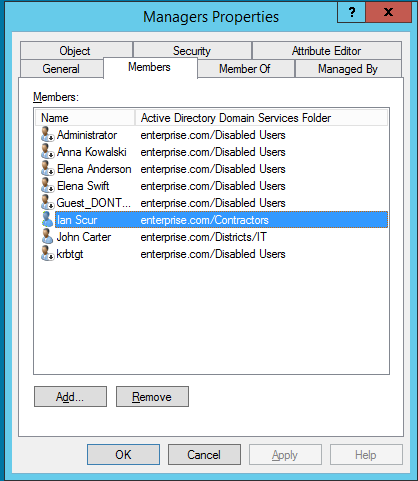
five. Click Add.
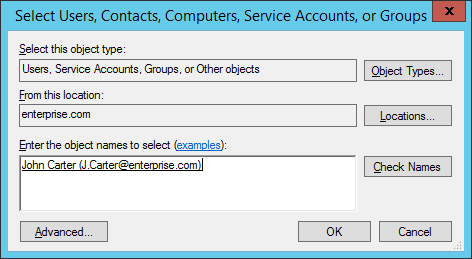
six. Enter the name of the user to add to the group (if you specify multiple users, split up the names using semicolons), then click Check Names. Alternatively, you can use Advanced button to search for the users i by one.
7. Select each of the users you desire to add to the group, and and so click OK.
Remove a user from a group
1. Correct-click the domain from which you want to remove the user and then select
2. Select Users, Contacts, and Groups in the Find dropdown list.
3. Enter the name of the group you lot desire to remove the user from and click Find At present.
4. Right-click the group and select Properties.
5. Become to the Members tab, highlight the user and click Remove.
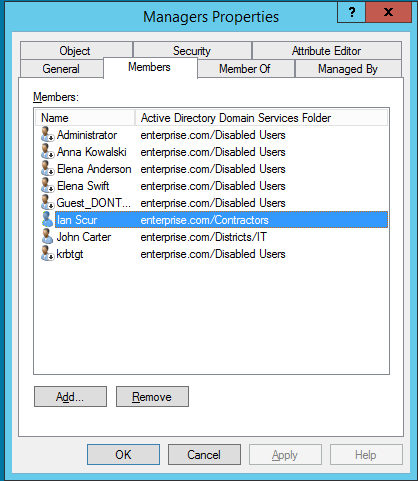
Disable a user account
1. Select the user's domain and aggrandize its contents.
2. Right-click the user'southward account. (To select multiple users, concur downward the CTRL). So click Disable Account.
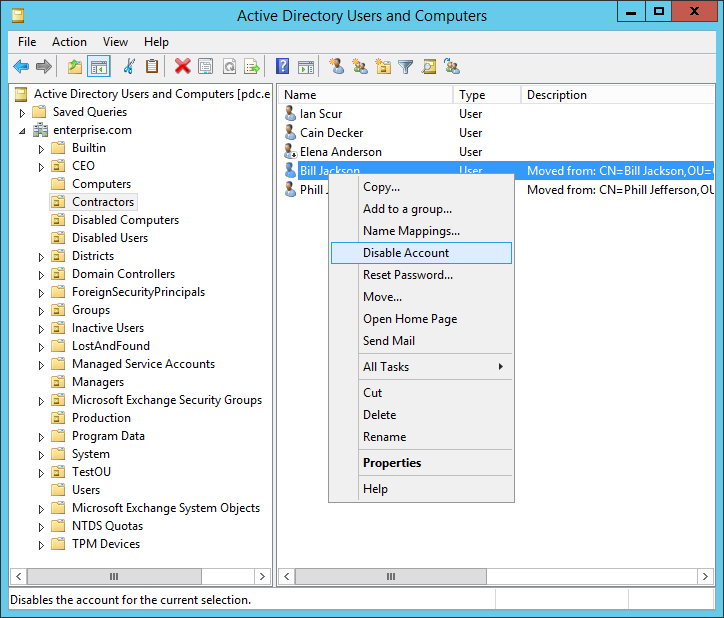
Reset a user'southward password
1. Navigate to the Users folder of the user's domain.
2. Right-click the user's proper name, choose All Tasks and select Reset Countersign.
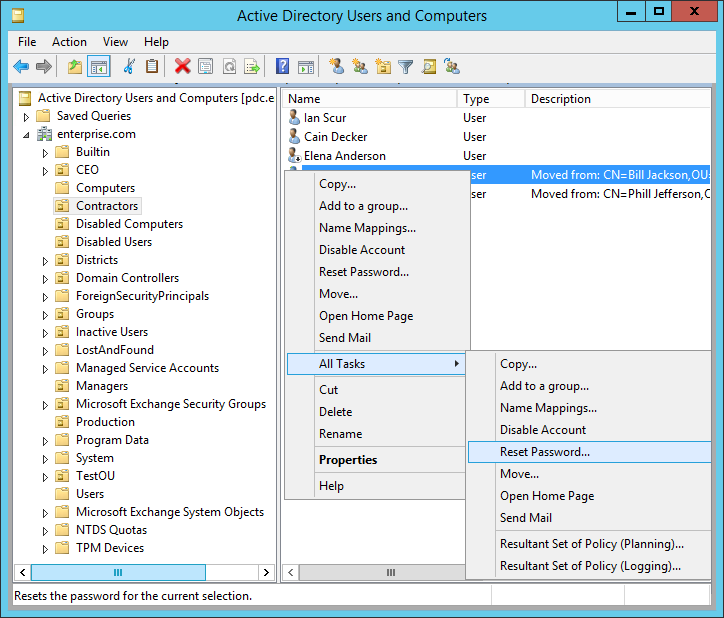
iii. Type a new countersign, type it once again in the Confirm password box, and so click OK.
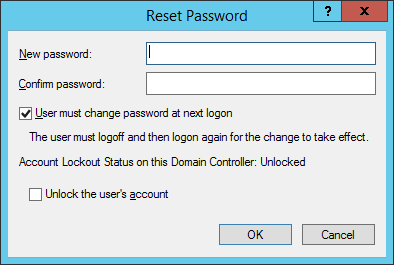
Move a user to some other OU
i. Right-click Active Directory Users and Computers and select Connect to Domain.
2. Enter the name of the user's domain and click OK.
iii. Right-click the user and select Move.
4. Cull the container you want to movement the user to so click OK.
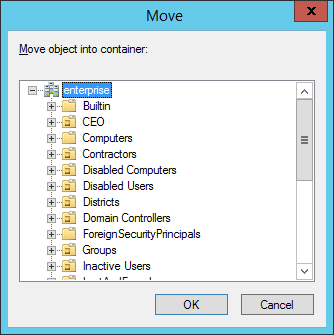
Change a user'south data
1. Correct-click Active Directory Users and Computers and select Connect to Domain.
two. Enter the proper name of the user's domain and click OK.
3. Right-click the user and select Properties.
4. Navigate to the tab containing the information you want to change, make your edits, and click
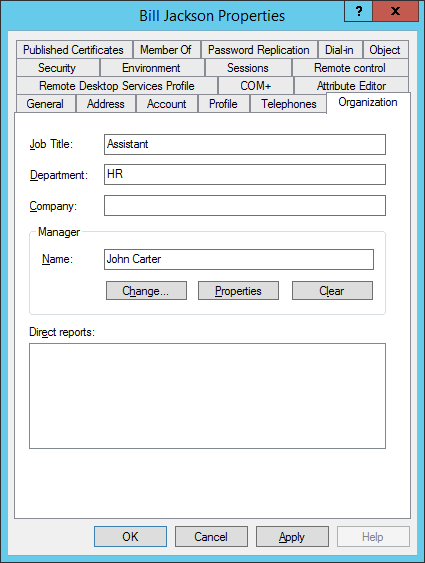
Other Tools in RSAT for Managing Agile Directory
Here are some of the other tools included in RSAT:
- Active Directory Authoritative Center — Use to manage the AD trash tin and password policies, and to display your PowerShell history
- Active Directory Module for Windows PowerShell — Install to enable PowerShell cmdlets for administering AD
- Active Directory Domains and Trusts — Allows you to manage functional level, wood functional level and user chief names (UPNs), likewise as trust between forests and domains
- Agile Directory Sites and Services — Lets you view and manage your sites and services
- ADSI Edit — Provides some functionality for managing AD objects, but nearly experts recommend using ADUC instead
FAQ
- What ADUC is used for?
ADUC is a Microsoft Management Panel (MMC) snap-in that enables administrators to manage Active Directory objects and their attributes. For example, they tin can:
- Change passwords
- Reset user accounts
- Add users to security groups
- Create and delete organizational units (OUs)
- Handle FSMO roles like RID master, PDC Emulator and infrastructure principal
- Create and manage computers, groups and users and their attributes
- Delegate control of objects
- Ascertain avant-garde security and auditing in Advertisement
You can discover more data about Active Directory basics in our Advertizing tutorial for beginners.
- How practice I get Active Directory Users and Computers on Windows 10?
In Windows 10 version 1809 or higher, you tin enable ADUC past going to Settings >Apps and Features > Optional features > Add a feature. In older versions of Windows, to get ADUC, you lot need to download and install the RSAT package manually.
- How do I install RSAT on Windows 10?
Starting with the October 2018 update to Windows 10, RSAT is included as a set of "Features on Demand," so yous don't need to install it. You simply need to enable the specific RSAT tools you require past going to Settings > Apps and Features > Optional features > Add together a feature.
If you're using an before version of Windows, you need to manually download and install RSAT.
- What is RSAT tool?
The Remote Server Administration Tool enables you to remotely manage Windows Server services and features from a Windows computer.
- What is included in Remote Server Assistants Tools?
RSAT has a busload of tools, including ADUC, Active Directory Module for Windows PowerShell and Agile Directory Administrative Center (ADAC).

Source: https://blog.netwrix.com/2017/01/30/active-directory-users-and-computers-aduc/
Posted by: fullercultin.blogspot.com


0 Response to "How To Find Active Directory"
Post a Comment